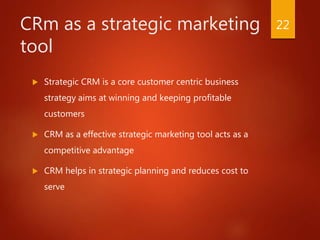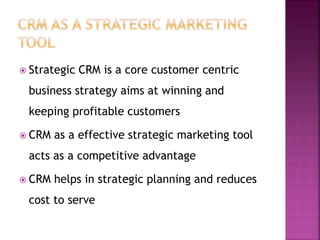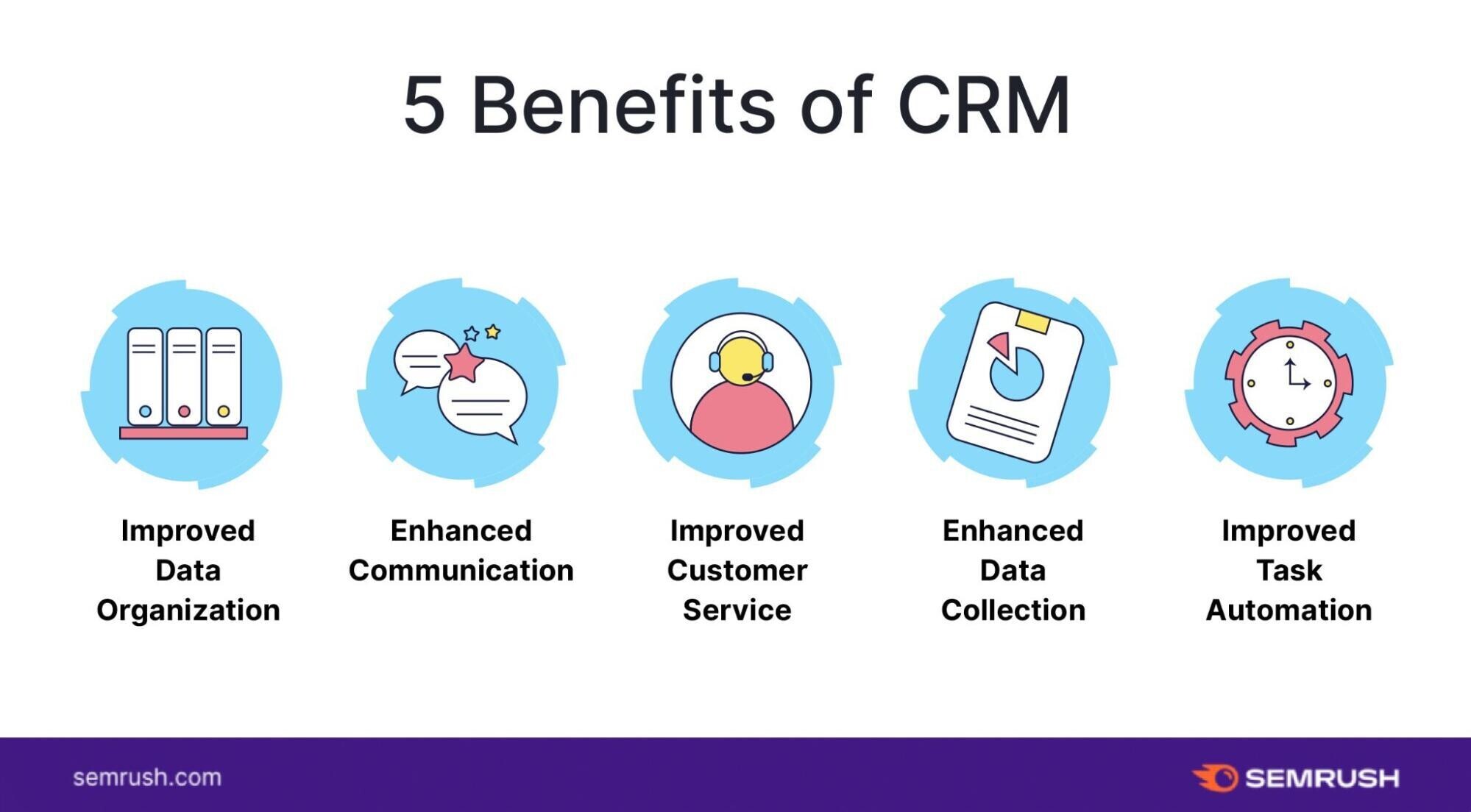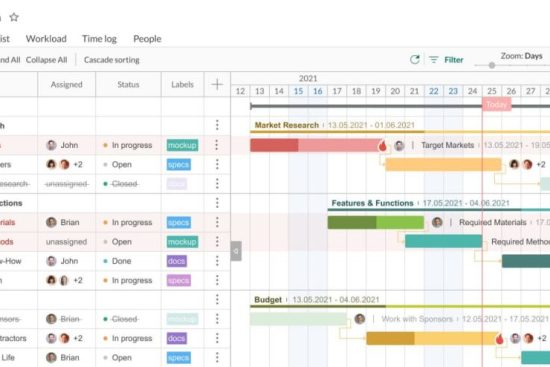
In today’s digital age, businesses need effective tools to stay competitive. CRM systems have become essential for strategic marketing.
Customer Relationship Management (CRM) isn’t just for organizing contacts. It’s a powerful tool for crafting personalized marketing strategies. By leveraging CRM, businesses can better understand customer behavior. This leads to more targeted campaigns and higher engagement rates. CRMs collect and analyze customer data, providing valuable insights.
These insights help in making informed decisions, optimizing marketing efforts, and enhancing customer experiences. Moreover, a well-implemented CRM system can streamline communication, improve customer retention, and increase revenue. So, let’s explore how CRM can be a strategic asset in your marketing toolkit.

Credit: www.slideshare.net
Benefits Of Crm
Customer Relationship Management (CRM) systems offer numerous benefits for businesses. These systems streamline processes and provide valuable insights. Companies can use these insights to enhance customer interactions and drive growth. Below, we explore some key benefits of CRM systems.
Enhanced Customer Relationships
CRM systems help businesses build stronger relationships with their customers. They store detailed information about customer preferences and interactions. This data allows businesses to personalize their communication. Tailored messages make customers feel valued and understood. Personalized interactions can lead to increased customer loyalty and satisfaction.
Improved Data Management
CRM systems centralize customer data in one place. This makes it easy to access and manage. Businesses can track customer interactions, sales, and support requests. Centralized data ensures all team members have up-to-date information. Accurate data helps in making informed decisions. It also reduces the chances of errors and data duplication.
Crm Strategies
Effective CRM strategies help businesses manage customer relationships. They improve sales, marketing, and customer service. By using CRM tools, companies can better understand their customers. This leads to more targeted and personalized marketing efforts.
Customer Segmentation
Customer segmentation divides a customer base into smaller groups. These groups share similar characteristics. These can include age, location, buying habits, and more. Segmentation helps businesses tailor their marketing strategies. They can send the right message to the right audience.
Segmentation makes marketing more efficient. It reduces wasted resources. By focusing on specific groups, businesses can increase engagement. This leads to higher conversion rates and better customer retention.
Personalized Marketing
Personalized marketing tailors messages to individual customers. It uses data from CRM systems to understand customer preferences. Personalized emails, product recommendations, and promotions can be created.
Customers feel valued when they receive personalized messages. This builds loyalty and trust. It also increases the chances of repeat purchases. Personalization can significantly improve customer satisfaction.
CRM systems make it easier to implement personalized marketing. They provide valuable insights into customer behavior. These insights help businesses create more relevant and engaging content.
Implementing Crm
Implementing CRM is a critical step for businesses. It helps in managing customer relationships efficiently. This process involves selecting the right software and training your team. Proper implementation can lead to better customer engagement and higher sales.
Choosing The Right Crm Software
Choosing the right CRM software is the first step. There are many options available in the market. Identify your business needs first. Look for features that align with your goals. Ensure the software is easy to use. It should integrate with your existing systems. Check for customer support and training options. Read reviews and testimonials. Consider the cost as well. A good CRM should offer value for money.
Training Your Team
Training your team is crucial after selecting the CRM. They must understand how to use the software. Start with basic training sessions. Use simple and clear instructions. Provide hands-on practice. Create a manual or guide for reference. Encourage questions and feedback. Regular training updates keep the team informed about new features. Well-trained employees can leverage CRM effectively. This leads to improved customer satisfaction and business growth.

Credit: www.spiceworks.com
Crm And Customer Retention
Customer Relationship Management (CRM) systems play a vital role in customer retention. They help businesses understand their customers’ needs better. A well-implemented CRM can enhance customer loyalty. This leads to repeat business and long-term relationships.
CRM systems gather and store customer data. This data helps businesses create personalized experiences. These experiences make customers feel valued. Happy customers are more likely to stay loyal to a brand. Let’s explore how CRM aids customer retention through loyalty programs and feedback mechanisms.
Loyalty Programs
Loyalty programs are an effective way to retain customers. CRM systems can track customer purchases. They can identify loyal customers. Based on this data, businesses can offer rewards and incentives. Points, discounts, or special offers can be given to loyal customers.
These rewards make customers feel appreciated. They are more likely to return to the business. CRM systems make managing loyalty programs easier. They automate point tracking and reward distribution. This ensures a seamless experience for the customers.
Feedback Mechanisms
Customer feedback is crucial for any business. CRM systems help in gathering and analyzing customer feedback. They can send automated surveys after a purchase. This allows businesses to understand customer satisfaction levels.
Analyzing feedback helps identify areas for improvement. Addressing these issues can enhance customer satisfaction. A satisfied customer is more likely to stay loyal. CRM systems also help in responding to feedback quickly. This shows customers that their opinions matter.
Effective feedback mechanisms can turn unhappy customers into loyal ones. CRM systems ensure that no feedback goes unnoticed. They help businesses maintain a positive relationship with their customers.
Measuring Crm Success
Understanding the success of your CRM system is crucial. It helps you determine if your investment is paying off. Measuring CRM success involves tracking various metrics. These metrics can provide insights into how well your CRM is working.
Key Performance Indicators
Key Performance Indicators (KPIs) are essential for measuring CRM success. They help you assess the effectiveness of your strategies. Here are some important KPIs to consider:
- Customer Retention Rate: Indicates the percentage of customers who stay with your company.
- Customer Lifetime Value (CLV): Measures the total revenue a customer generates over their lifetime.
- Customer Satisfaction Score (CSAT): Gauges how happy customers are with your services.
- Net Promoter Score (NPS): Shows how likely customers are to recommend your company.
These KPIs give you a clear picture of your CRM’s impact. They help you identify areas for improvement.
Roi Analysis
Return on Investment (ROI) is another critical metric. It shows the financial benefits of your CRM system. To calculate ROI, use the following formula:
ROI = (Net Profit / Cost of Investment) x 100Here’s a simple table to illustrate the calculation:
| Net Profit | Cost of Investment | ROI |
|---|---|---|
| $50,000 | $10,000 | 500% |
A high ROI indicates that your CRM is delivering good value. A low ROI means you need to revisit your CRM strategy.
By focusing on KPIs and ROI, you can measure CRM success effectively. This helps you make informed decisions and improve your marketing efforts.
Challenges In Crm Adoption
Adopting CRM systems can be a significant strategic decision for businesses. Yet, many companies face hurdles during implementation. Understanding these challenges is crucial for a smooth transition. Here, we discuss the common obstacles and provide practical solutions.
Common Obstacles
Many employees resist new technologies. They might feel overwhelmed by new systems. Training becomes a key issue.
Data integration is another challenge. Systems must work together seamlessly. This requires careful planning.
High costs can be a barrier. Small businesses often struggle with budget constraints. This affects their adoption decisions.
Solutions And Best Practices
Start with proper training programs. Educate employees on the benefits of CRM. This can ease resistance and improve acceptance.
Ensure data integration is smooth. Use compatible systems. This avoids disruptions and improves efficiency.
Opt for scalable CRM solutions. Begin with a basic plan. Upgrade as your business grows. This can help manage costs effectively.
Regularly review your CRM strategy. Assess its impact on your business. Make adjustments based on feedback and performance.
Future Trends In Crm
Customer Relationship Management (CRM) is evolving rapidly. New trends are shaping the future of CRM. These trends aim to make customer interactions smoother and more effective. Let’s explore some key trends that will define the future of CRM.
Ai And Automation
Artificial Intelligence (AI) and automation are revolutionizing CRM. AI helps in predicting customer behavior. It can analyze large datasets quickly. This helps in making data-driven decisions. Automation, on the other hand, streamlines repetitive tasks. This saves time and reduces human error. Automated workflows ensure consistency in customer interactions.
For example:
- Chatbots: Provide instant customer support.
- Email Marketing: Send personalized emails based on customer behavior.
- Lead Scoring: Identify and prioritize high-value leads.
AI and automation together can enhance customer experience significantly.
Integration With Other Tools
CRM systems are becoming more versatile. They are integrating with other business tools. This integration provides a seamless flow of information. It helps in creating a unified customer view. Common integrations include:
| Tool | Purpose |
|---|---|
| Marketing Automation | Automate marketing tasks and campaigns. |
| ERP Systems | Streamline business processes and data management. |
| Social Media Platforms | Monitor and engage with customers on social media. |
Integration enhances the functionality of CRM. It ensures that all customer interactions are tracked. This leads to better customer insights and improved service.
Case Studies
Exploring real-world examples of CRM implementations can provide valuable insights. By studying these cases, businesses can learn effective strategies and common pitfalls. This section delves into two specific areas: Successful CRM Implementations and Lessons Learned.
Successful Crm Implementations
Several companies have successfully implemented CRM systems. These examples show the potential benefits of a well-executed CRM strategy.
| Company | Industry | CRM System | Results |
|---|---|---|---|
| Company A | Retail | Salesforce |
|
| Company B | Healthcare | HubSpot |
|
Lessons Learned
Learning from others’ experiences can help avoid common mistakes. Below are key lessons from successful and less successful CRM implementations.
- Understand Your Needs: Tailor the CRM to meet specific business requirements.
- Employee Training: Ensure thorough training for all users to maximize system benefits.
- Data Quality: Maintain clean, accurate data for reliable insights.
- Customer-Centric Approach: Focus on improving the customer experience.
- Regular Updates: Keep the CRM system updated to leverage new features.
By following these guidelines, businesses can enhance their CRM strategies. This ultimately leads to better customer relationships and improved business performance.

Credit: www.semrush.com
Frequently Asked Questions
What Is Crm In Marketing?
CRM stands for Customer Relationship Management. It helps businesses manage and analyze customer interactions. It enhances customer satisfaction and boosts sales.
How Does Crm Help In Marketing?
CRM helps by organizing customer information, tracking interactions, and providing insights. This enables personalized marketing campaigns and improves customer engagement.
Why Is Crm A Strategic Tool?
CRM is strategic because it centralizes customer data. It aids in decision-making, improves customer relationships, and increases efficiency in marketing efforts.
Can Crm Improve Customer Retention?
Yes, CRM improves customer retention by providing valuable insights. It helps in understanding customer needs and fostering long-term relationships through personalized interactions.
Conclusion
CRM systems enhance marketing strategies. They help businesses understand their customers better. Effective CRM use leads to improved customer relationships. These relationships drive customer loyalty and increase sales. CRM tools streamline marketing efforts and provide valuable insights. This makes marketing more effective and targeted.
By integrating CRM, businesses stay competitive. They can also adapt quickly to market changes. Utilize CRM to its full potential. This can transform your marketing approach. Embrace CRM as a key tool in your strategy. Doing so ensures long-term success and growth.

